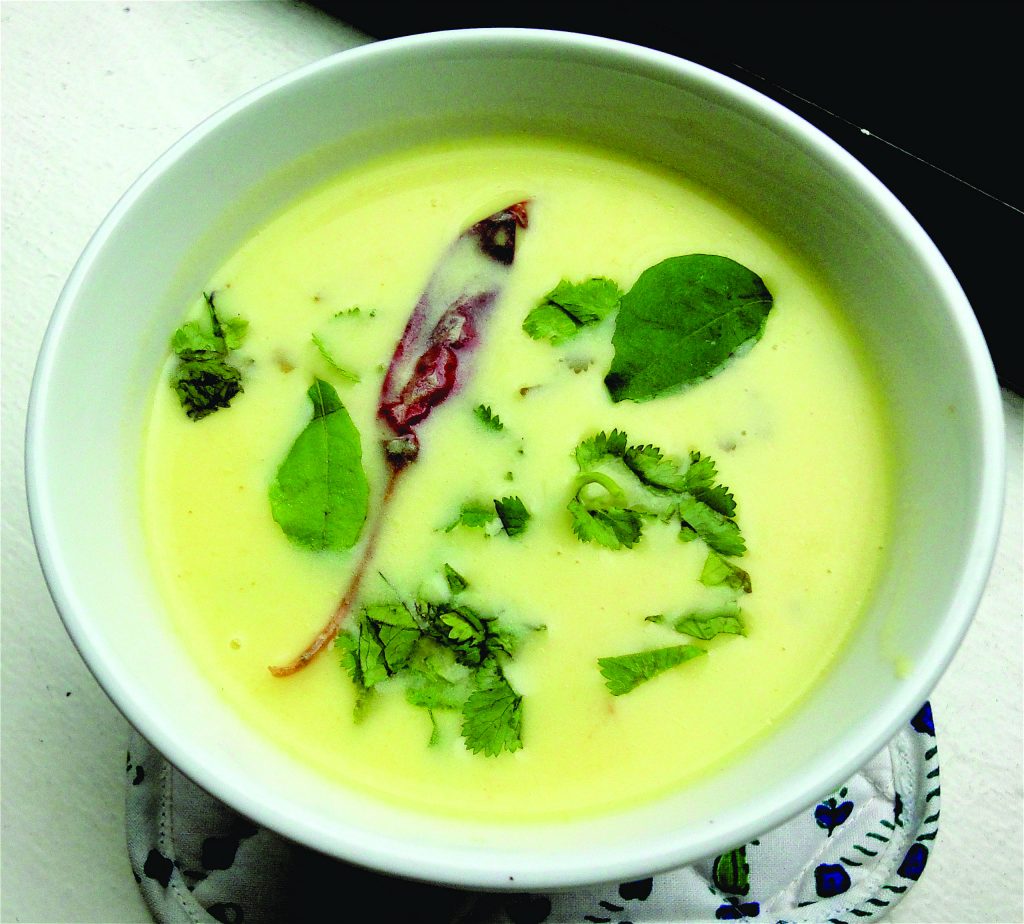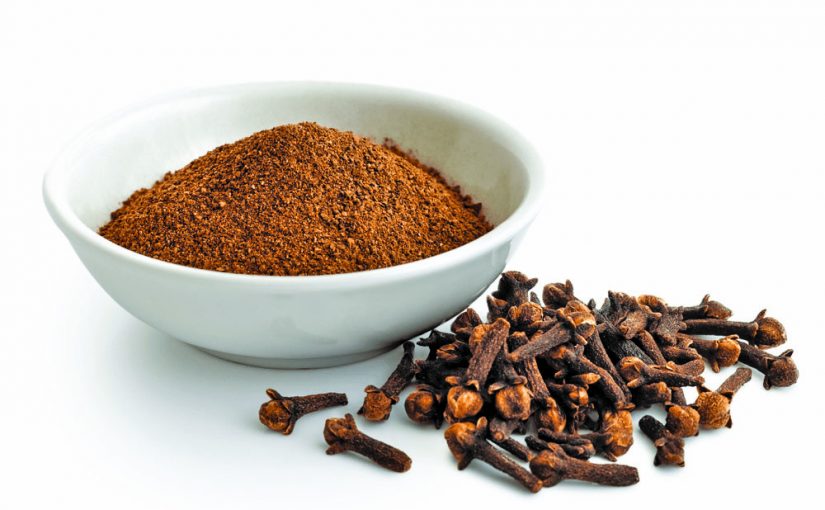Cloves or laung are aromatic flower buds of an evergreen tree in the family Myrtaceae, native to Indonesia…dark, woodsy, warm beauties to liven up a soup or a buttermilk kadi or whatever else you wish. Cloves are anti-microbial, anti-fungal, antiviral, antiseptic and stimulating properties. Bring a single clove to a boil in a cup of water and sip clove tea hot, or cold…a brainy tea! (Inset) Try making Gujarat’s golden buttermilk kadi spiked with clove powder or whole cloves.
By Tara Narayan
THIS week of continuing coronavirus lockdown (getting on my nerves) I’ve decided to dream of …er…a wonder spice called cloves. This is because after a long time I was listening to celebrity maestro healer Luke Coutinho waxing lyrical over spice flower – cloves. Did you ever think that cloves are flowers or rather flower buds…dark, aromatic, immediately charming? When did you last look at a clove and think about it? Cloves are flower buds of the evergreen family of Myrtaceae, called Syzygium aromaticum…
Ever seen a clove tree, it’s really a small tree and when the cloves turn up they are beautifully velvety green Don’t know if they’re dried out in the shade or hot sunshine but when we buy them they’re got this gorgeous dark deep brown color converging to almost a hint of black. Frankly, I’d say all our spices are a royal family with very many healthful properties enshrined in them and it’s a pity we don’t court them more often to keep body beautiful fighting fit from the inside out and outside in. I mean look how wars were fought and civilizations colonized, converted by hook or by crook, for such prime economical reasons as the spice trade of old…how much Portugal and Spain, England and France, the Dutch… the Arabs too from the Middle East, wanted the spices of the fabled spice lands across the seas and oceans based in South East Asia, in Burma, Malaya, Borneo and other islands I can’t recall right now.
We know all know of the charms of black pepper, nutmeg, cloves, cardamom, cinnamon and other members of the community of spices…star anise! How about bay leaves, all-spice leaves? In our Indian kitchen spice box of old there will be cumin seeds, fenugreek seeds, onion seeds, aniseed, coriander seeds…dhania-jeera powder, turmeric powder, not to forget the dainty strongly fragrant asafetida or hing! What’s a recipe phodni without a pinch of sizzled hing in it?
But thanks to Luke Coutinho this week I’ve got dark brown woodsy cloves on my mind. Once upon a time in Mumbai I used to add a pinch or two of “taj-lavang” or cinnamon-clove fine powder as a final touch to every Guju kadi I made with buttermilk and oh what a heady soupy kadi it was to savor…with curry leaves and chopped coriander greens swirling in it, in between the gentle whiff of cinnamon and/or clove…pretty to look at, divine to sip. Dip your phulka in a thin flavorful kadi or pour it atop your mound of rice with a dollop of ghee, tomato-onion kachumbar (relish) on the side.
Evenings and Sundays in Guju homes are reserved for a for a firm tur dal kichdi and just so spiced up buttermilk kadi – sometimes it would be bhinda kadi, or boondi kadi, or palak kadi, or wadiyon kadi! One may just about add anything to a basic kadi…and yes, don’t forget that last final pinch of taj-lavang or only clove masala! Thin and aromatic consommé styled kadi or thick and rich with veggies hearty kadi. Before I forget I also like my drumstick kadi…if you don’t want to chew on the drumsticks, pre-steam cook them and scoop out the meaty seedy flesh, add to kadi, truly delicious.
All the uses for cloves: add a couple in a traditional semolina halva done in desi cow’s ghee; patisserie chefs like to add clove powder to cake and cookie batters and biscuits; in savory baked dishes (in bread pudding!); add a pinch of clove powder to a hot drink of chocolate…cloves are “lavang” in Hindi. Some housewives I know add a clove or two to white dairy cow’s butter simmering into ghee at home (it is clove or a green betal leaf to get a fine golden ghee).
Cloves have very many healthful properties. It is one of the richest source of manganese which is essential mineral for making the brain function! Also building good bones. Also note all these other things about cloves: They are high in antioxidants which one can never have enough of in our eating habits for it is antioxidant food which reduces oxidative stress, keeps chronic diseases at bay. Cloves have a compound called eugenol and this is a natural antioxidant, most of us know that clove oil makes for excellent oral health…can gargle with a drop of clove oil in water.
Lots of studies have been done and in one test-tube study it was revealed that clove’s eugenol stopped oxidative damage caused by free radicals five times more effectively than vitamin E (another potent antioxidant). There are other reasons to go fida over cloves…they are anti-cancer, reduce tumor formation; useful for stomach ulcers; have antimicrobial properties and can take care of fatty livers, help them detox….but never ever overdo on cloves or clove oil — too much clove anything can damage liver and other things. So be warned, some may be allergic to cloves, cloves can sting delicate tissues, very often while very little works, a little more or too much can end in worst case scenarios!
Apart from that I would say go ahead and discover or re-discover the charms of having cloves at home. Bring a clove to boil in water and sip clove tea…cheers! Never ever use more than one or two or three cloves in any raw usage…and ah yes, I remember a grandmother who used to keep a prized potli of cloves, cardamom, cinnamom, star anise and a silver coin amidst clothes in the cupboard in the old days? Why silver coin don’t ask me! Anyway, sarees emerged scented of spice when one decided to drape oneself up! Good idea. A spice potli can keep discourage the usual critters which invade cupboards. Spice potli can be so romantic too. Can keep a clove in your mouth as a mouth freshner.
What else? Cloves are expensive of course like most spices today. They’re native to the islands of Indonesia and especially Maluku islands …hey, I’ve just learned that in India and in particular in Siddha and Ayurveda medicine cloves are prescribed as a remedy for heartburn (maybe heartbreak too!), some would say cloves can thin your blood (act like aspirin, but remember too much clove can also make your break out in bleeding, like too much aspirin).
This is to finally say cherish cloves and treat them with respect, cloves are antimicrobial, anti-fungal, anti-viral, antiseptic, stimulating…home remedy! A tomato soup comes gloriously alive with a pinch of clove powder. It’s worth getting familiar with cloves and studying them up some more. Did you know that ginger has salicylates and can also double as a blood thinner? But these days for love or for money I can’t find good fresh ginger, all the ghastly ginger from Belgaum comes with greyish fungal rings within and in health shops I search for expensive organically cultivated ginger, wondrously yellow and sharp in flavor within….ahhhh, this is ginger. I can pay `150 kg for it!
How I make my buttermilk kadi…

